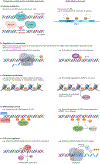Means, mechanisms and consequences of adenine methylation in DNA
- PMID: 35256817
- PMCID: PMC9354840
- DOI: 10.1038/s41576-022-00456-x
Means, mechanisms and consequences of adenine methylation in DNA
Abstract
N6-methyl-2'-deoxyadenosine (6mA or m6dA) has been reported in the DNA of prokaryotes and eukaryotes ranging from unicellular protozoa and algae to multicellular plants and mammals. It has been proposed to modulate DNA structure and transcription, transmit information across generations and have a role in disease, among other functions. However, its existence in more recently evolved eukaryotes remains a topic of debate. Recent technological advancements have facilitated the identification and quantification of 6mA even when the modification is exceptionally rare, but each approach has limitations. Critical assessment of existing data, rigorous design of future studies and further development of methods will be required to confirm the presence and biological functions of 6mA in multicellular eukaryotes.
© 2022. Springer Nature Limited.
Conflict of interest statement
Competing interests
The authors declare no competing interests.
Figures




Similar articles
-
DNA N6-methyldeoxyadenosine in mammals and human disease.Trends Genet. 2022 May;38(5):454-467. doi: 10.1016/j.tig.2021.12.003. Epub 2022 Jan 3. Trends Genet. 2022. PMID: 34991904 Free PMC article. Review.
-
N6-methyladenine functions as a potential epigenetic mark in eukaryotes.Bioessays. 2015 Nov;37(11):1155-62. doi: 10.1002/bies.201500076. Epub 2015 Aug 21. Bioessays. 2015. PMID: 26293475 Review.
-
N6-Methyladenine: A Conserved and Dynamic DNA Mark.Adv Exp Med Biol. 2016;945:213-246. doi: 10.1007/978-3-319-43624-1_10. Adv Exp Med Biol. 2016. PMID: 27826841 Free PMC article. Review.
-
The exploration of N6-deoxyadenosine methylation in mammalian genomes.Protein Cell. 2021 Oct;12(10):756-768. doi: 10.1007/s13238-021-00866-3. Epub 2021 Aug 17. Protein Cell. 2021. PMID: 34405377 Free PMC article. Review.
-
N6-methyladenine: A Rare and Dynamic DNA Mark.Adv Exp Med Biol. 2022;1389:177-210. doi: 10.1007/978-3-031-11454-0_8. Adv Exp Med Biol. 2022. PMID: 36350511
Cited by
-
Epigenetic Peripheral Biomarkers for Early Diagnosis of Alzheimer's Disease.Genes (Basel). 2022 Jul 22;13(8):1308. doi: 10.3390/genes13081308. Genes (Basel). 2022. PMID: 35893045 Free PMC article. Review.
-
Mammalian DNA N6-methyladenosine: Challenges and new insights.Mol Cell. 2023 Feb 2;83(3):343-351. doi: 10.1016/j.molcel.2023.01.005. Mol Cell. 2023. PMID: 36736309 Free PMC article. Review.
-
Global DNA Adenine Methylation in Caenorhabditis elegans after Multigenerational Exposure to Silver Nanoparticles and Silver Nitrate.Int J Mol Sci. 2023 Mar 24;24(7):6168. doi: 10.3390/ijms24076168. Int J Mol Sci. 2023. PMID: 37047139 Free PMC article.
-
Drosophila TET acts with PRC1 to activate gene expression independently of its catalytic activity.Sci Adv. 2024 May 3;10(18):eadn5861. doi: 10.1126/sciadv.adn5861. Epub 2024 May 3. Sci Adv. 2024. PMID: 38701218 Free PMC article.
-
Navigating the pitfalls of mapping DNA and RNA modifications.Nat Rev Genet. 2023 Jun;24(6):363-381. doi: 10.1038/s41576-022-00559-5. Epub 2023 Jan 18. Nat Rev Genet. 2023. PMID: 36653550 Free PMC article. Review.
References
-
- Janulaitis A, Klimasauskas S, Petrusyte M & Butkus V Cytosine modification in DNA by BcnI methylase yields N4-methylcytosine. FEBS Lett. 161, 131–134 (1983). - PubMed
-
- Grosjean H in DNA and RNA Modification Enzymes: Structure, Mechanism, Function and Evolution (ed Grosjean H) Ch. 1, 1–18 (CRC Press, 2009).
Publication types
MeSH terms
Substances
Grants and funding
LinkOut - more resources
Full Text Sources

